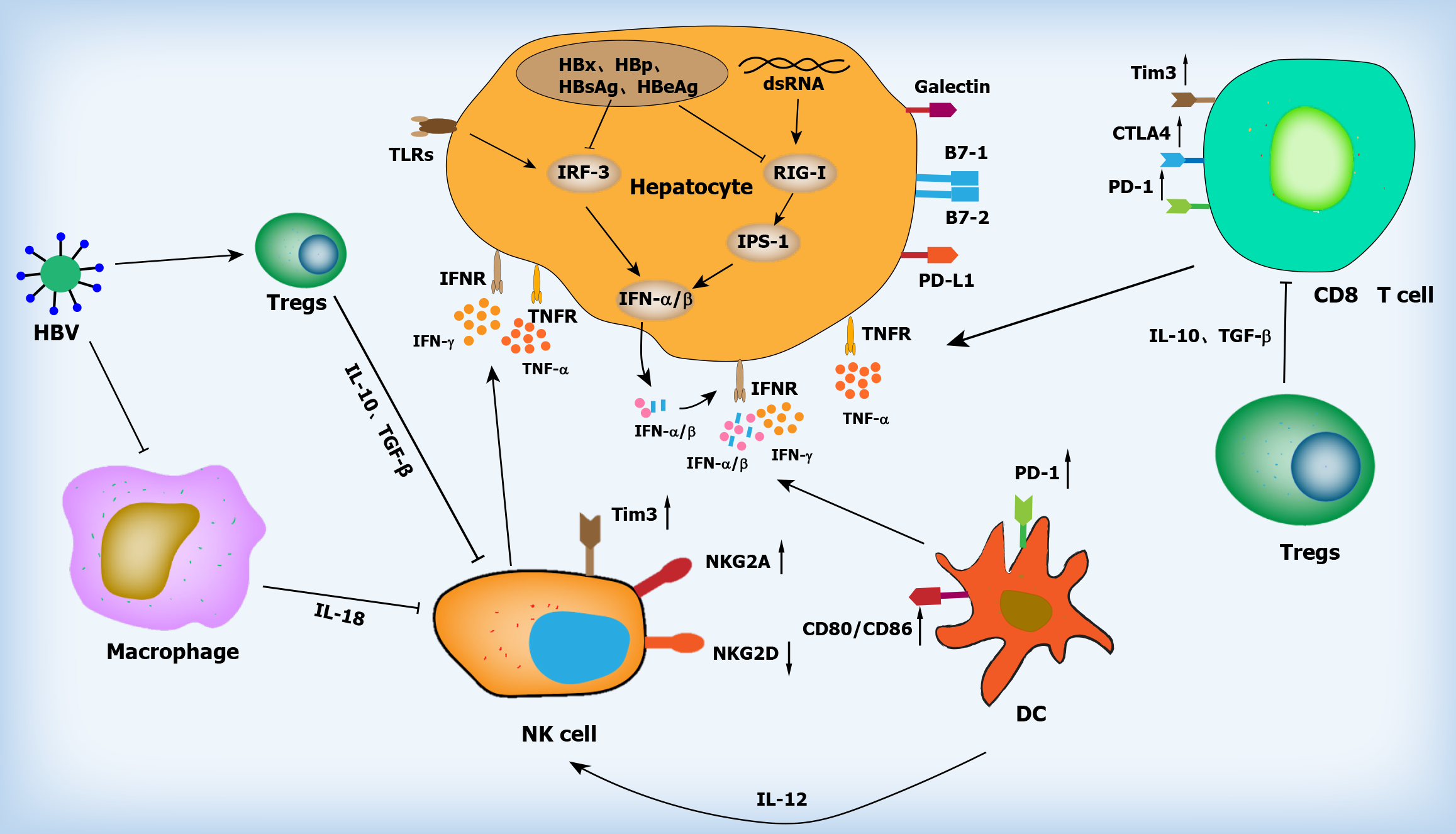Copyright
©The Author(s) 2025.
World J Gastrointest Oncol. Jan 15, 2025; 17(1): 93983
Published online Jan 15, 2025. doi: 10.4251/wjgo.v17.i1.93983
Published online Jan 15, 2025. doi: 10.4251/wjgo.v17.i1.93983
Figure 1 Hepatitis B virus immune tolerance mechanism.
In hepatocyte, hepatitis B virus (HBV) inhibits toll-like receptors mediated interferon (IFN)-α/β production by blocking the activation of interferon regulatory factor 3 HBV interferes with the retinoic acid-inducible gene-I (RIG-I) signaling pathway in hepatocyte and inhibits the production of IFN-α/β by disrupting the interaction between mitochondrial antiviral-signaling protein and RIG-I. HBV affects the activation of natural killer (NK) cells by inhibiting the production of interleukin (IL)-18 by macrophages. HBV promotes the generation of Tregs, which release IL-10 and transforming growth factor β to increase the expression of surface inhibitory receptors on NK cells and CD8 + T cells, thereby reducing IFN and tumor necrosis factor-α release. The expression of immune checkpoints on the surface of CD8 + T cells increases, leading to T cell exhaustion, resulting in immune tolerance of HBV. IL: Interleukin; HBV: Hepatitis B virus; NK: Natural killer; IFN: Interferon; NKG2A: Natural killer group 2A; NKG2D: Natural killer group 2D; Tim-3: T-cell immunoglobulin and mucin domain-containing protein 3; DC: Dendritic cell; CD: Cluster of differentiation; PD-1: Programmed death-1; CTLA4: Cytotoxic T lymphocyte-associated protein 4; TGF: Transforming growth factor; PD-L1: Programmed cell death 1 ligand 1; TNF: Tumor necrosis factor; TLR: Toll-like receptors; IRF-3: Interferon regulatory factor 3; IPS-1: Interferon-β promoter stimulator 1; RIG-I: Retinoic acid-inducible gene-I.
Figure 2 The pathogenesis of liver cancer.
The occurrence of hepatocellular carcinoma is related to the abnormal activation of multiple signaling pathways. When there is a wnt signal, abnormalities in the AXIN gene can inhibit β-catenin degradation, accumulating in the cytoplasm and entering the nucleus to bind with T-cell factor family proteins, enhancing downstream gene transcription. In the presence of hedgehog (Hh) ligands, the binding of Hh ligand to patched (Ptch)-1 can lead to the endocytosis of Ptch-1, thereby relieving the inhibition of smoothened (Smo). The accumulation and activation of Smo lead to the dissociation of suppressor of fused and GLI, forming GLI activators that promote the expression of target genes. Notch protein is cleaved by furin like proteins and expressed on the cell surface in the form of heterodimers. After binding with ligands, it is cleaved by proteases, and then cleaved by γ-secretase complex in the transmembrane region. At this time, the activated molecule notch intracellular domain enters the nucleus to regulate the transcription of target genes. Hh: Hedgehog; Smo: Smoothened; TCF/LEF: Transcription factor T-cell factor/lymphoid enhancer factor.
- Citation: Wan H, Zhang YX, Shan GY, Cheng JY, Qiao DR, Liu YY, Shi WN, Li HJ. Antiviral therapy for hepatitis B virus infection is beneficial for the prognosis hepatocellular carcinoma. World J Gastrointest Oncol 2025; 17(1): 93983
- URL: https://www.wjgnet.com/1948-5204/full/v17/i1/93983.htm
- DOI: https://dx.doi.org/10.4251/wjgo.v17.i1.93983










